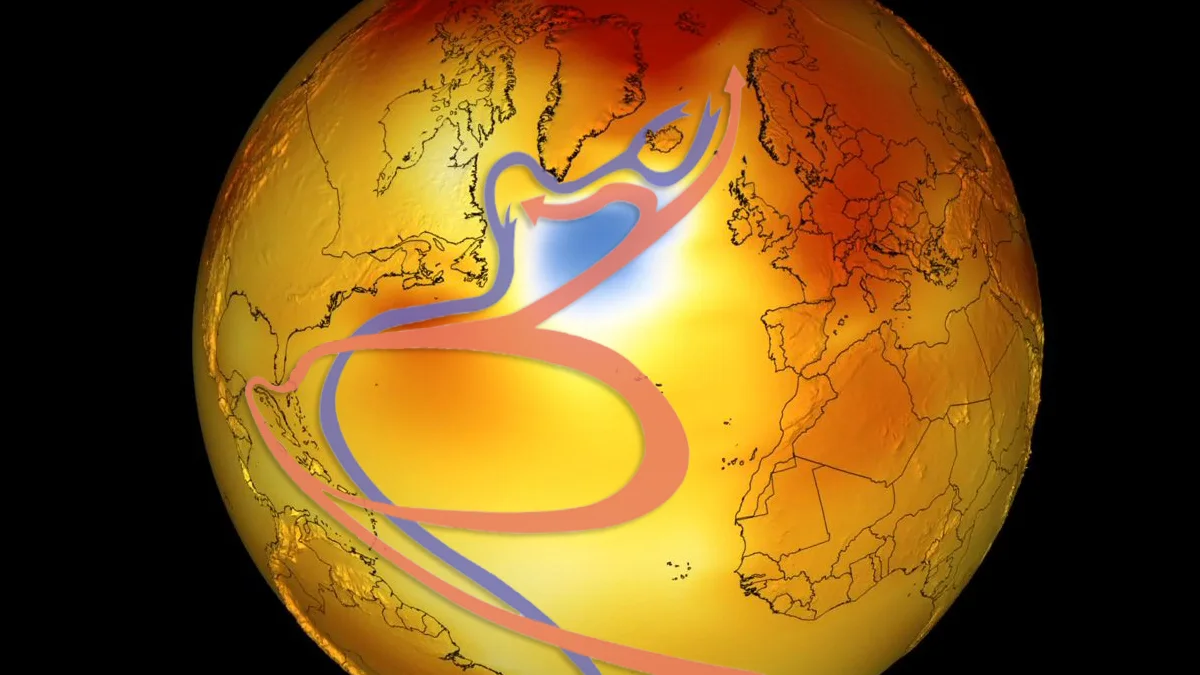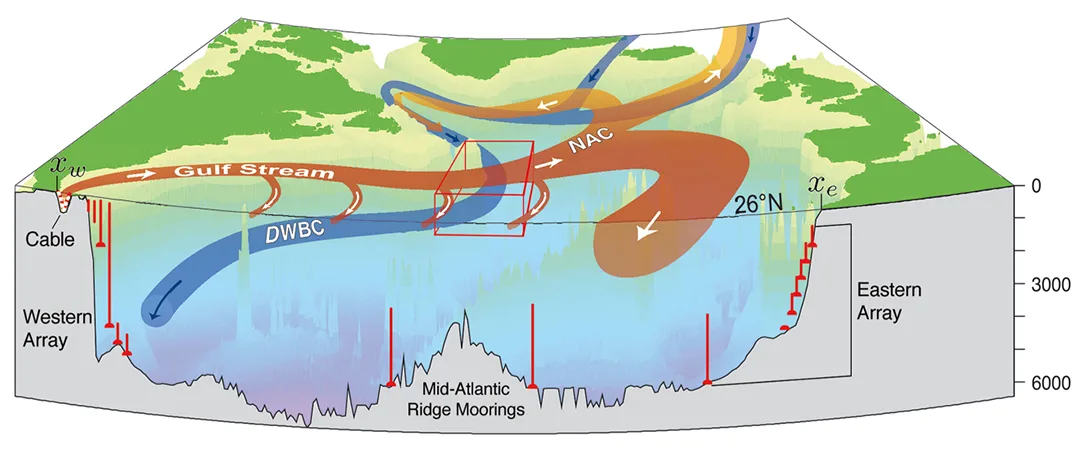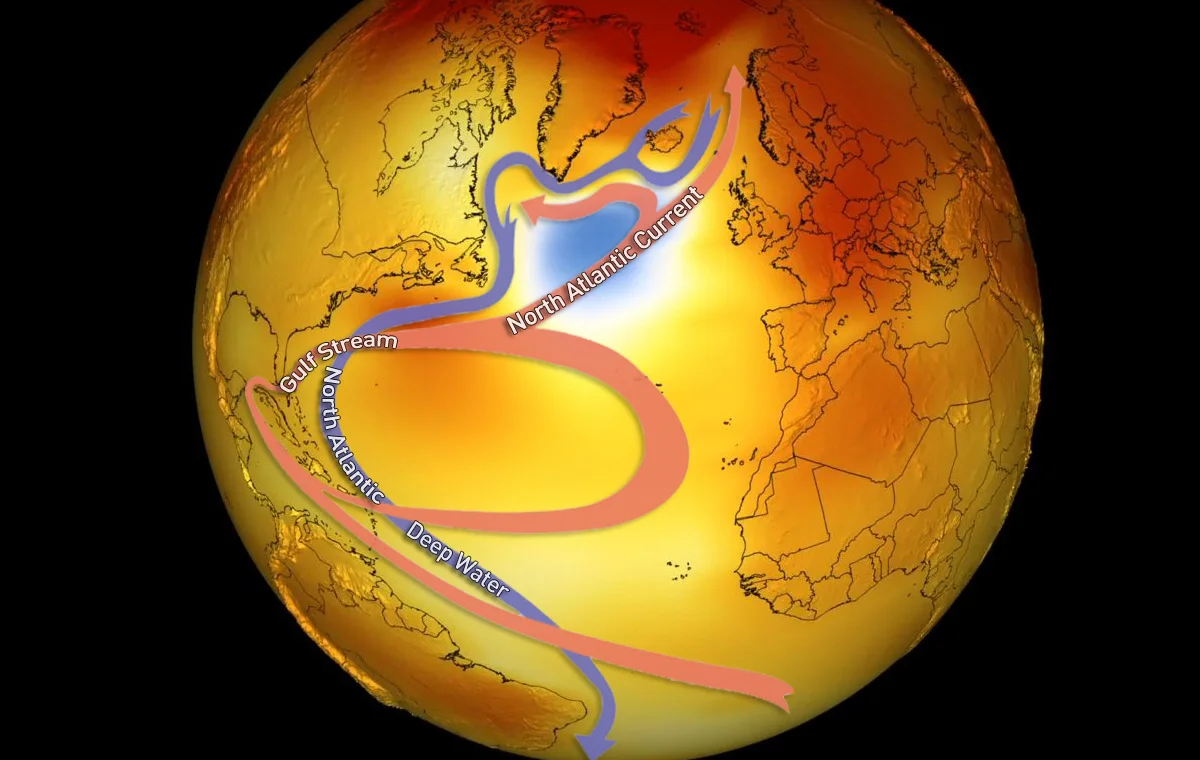
Gulf Stream current is now at its weakest in over 1,000 years
Climate change is causing currents in the North Atlantic to slow, and new research shows just how unprecedented this change is.
New research has revealed that the recent slowdown of the Gulf Stream current and the entire 'North Atlantic conveyor belt' is unprecedented in more than a millennium.
The Gulf Stream is one of the most important currents of water in all of the world's oceans. It is a warm flow of surface water that runs along the southeast coast of the United States and out into the Atlantic, where it then joins up with the North Atlantic Current to flow past Europe. This current has helped keep the Northern Hemisphere's climate relatively warm, especially in regions of northwestern Europe. It is estimated that the Gulf Stream and the larger Atlantic Meridional Overturning Circulation (AMOC) control roughly one-quarter of the heat transfer in the Northern Hemisphere.
"The Gulf Stream System works like a giant conveyor belt, carrying warm surface water from the equator up north and sending cold, low-salinity deep water back down south. It moves nearly 20 million cubic meters of water per second, almost a hundred times the Amazon flow," Stefan Rahmstorf, one of the authors of a new study published this week in Nature Geoscience, said in a press release from the Potsdam Institute for Climate Impact Research (PIK).

This diagram shows a cross-section view of the North Atlantic Ocean, with the warm surface ocean currents (the Gulf Stream and the North Atlantic Current (NAC), in red) and the cold, deep current (the Deep Western Boundary Current (DWBC), in blue). Credit: Bell/White/CSIRO, Buckley/Marshall/Reviews of Geophysics, NOAA
In the past decade, climate models have predicted that a slowdown in the AMOC was possible due to global warming. Climate studies have revealed evidence that the slowdown has been happening for several decades now and that it appears to be getting worse.
This new study gathered together data going back roughly 1,600 years to put these recent changes into perspective. While direct observations of the AMOC only became available starting in 2004, 'proxy' data — such as sediment grain sizes revealing the changes in deep-sea currents — goes back much further. By combining multiple sets of proxy data, the researchers, led by Levke Caesar of the Irish Climate Analysis and Research Units (ICARUS) at Maynooth University and the Potsdam Institute for Climate Impact Research (PIK), found that the current slowdown in the AMOC is unprecedented in at least the last 1,000 years.
"For the first time, we have combined a range of previous studies and found they provide a consistent picture of the AMOC evolution over the past 1,600 years. The study results suggest that it has been relatively stable until the late 19th century," Rahmstorf explained. "With the end of the little ice age in about 1850, the ocean currents began to decline, with a second, more drastic decline following since the mid-20th century."
Several studies of the AMOC have already linked this slowdown to human-caused global warming.
The entire ocean circulation in the North Atlantic runs on the differences in temperature and salt-content (salinity) of the water. Warm, salty surface water flows from the tropics to the Arctic. There, it will have cooled to the point where it becomes denser than the water around it and subsequently sinks. This draws in more water to 'fill the gap', thus driving the surface half of the conveyor. Meanwhile, the cold, dense water that sank then flows along the deep ocean back towards the south.
Increased rainfall amounts and the melting of the Greenland Ice Sheet, both caused by warming global temperatures, are adding more freshwater into the ocean's surface. This dilutes the salt content of the water, making it less dense. So, when it arrives in the north, the water takes longer to sink. As a result, the entire circulation slows down.

This graphic shows the AMOC superimposed on a map of average global temperatures from 2014-2018. The development of the 'cold blob' in the North Atlantic has been linked to the slowdown of the AMOC. Credits: AMOC taken from Stephan Rahmstorf (Nature, 1997, CC BY-SA 4.0), Background temperature map from NASA's Scientific Visualization Studio
A slower Gulf Stream and AMOC will likely have serious consequences all around the Atlantic Basin. It has already been implicated in the appearance of the North Atlantic 'cold blob', as shown in the graphic above. The change in heat flow to the north could also lead to more extreme winter weather events in northern Europe. Additionally, slower currents would result in a rapid rise in sea levels along the east coast of the United States.
"The northward surface flow of the AMOC leads to a deflection of water masses to the right, away from the U.S. east coast. This is due to Earth's rotation that diverts moving objects such as currents to the right in the northern hemisphere and to the left in the southern hemisphere. As the current slows down, this effect weakens and more water can pile up at the U.S. east coast, leading to an enhanced sea level rise," Caesar explained in the PIK press release.
The Gulf Stream and AMOC are just one part of the global thermohaline circulation, which transports heat and salt-content throughout the world's oceans. Thus, a slowdown in the North Atlantic conveyor could have even farther-reaching impacts.
"If we continue to drive global warming, the Gulf Stream System will weaken further — by 34 to 45 per cent by 2100, according to the latest generation of climate models," Rahmstorf added.
"This could bring us dangerously close to the tipping point at which the flow becomes unstable."

